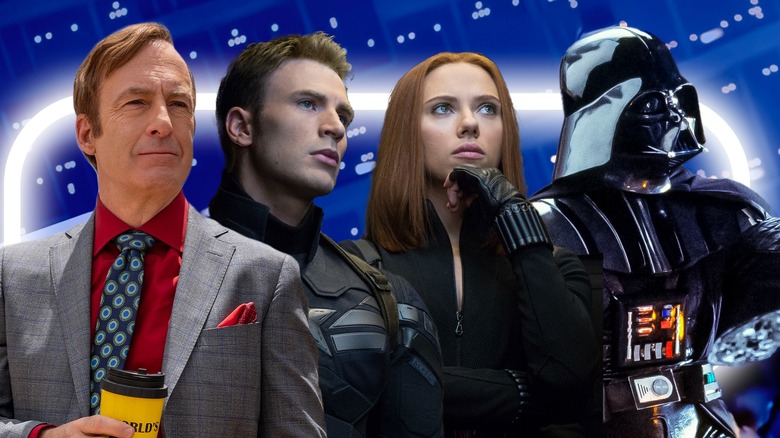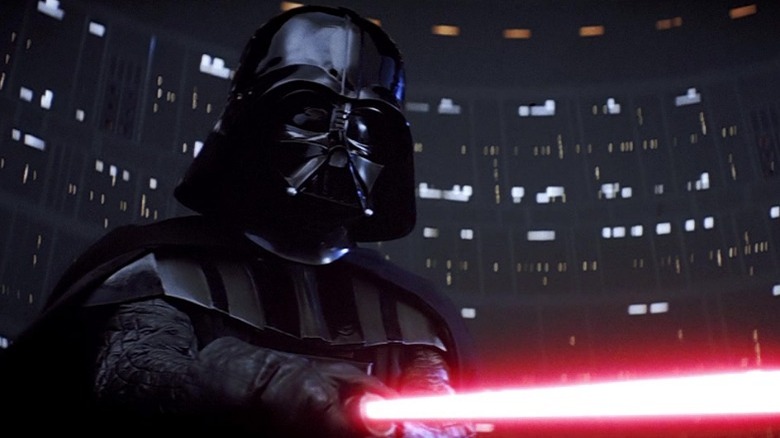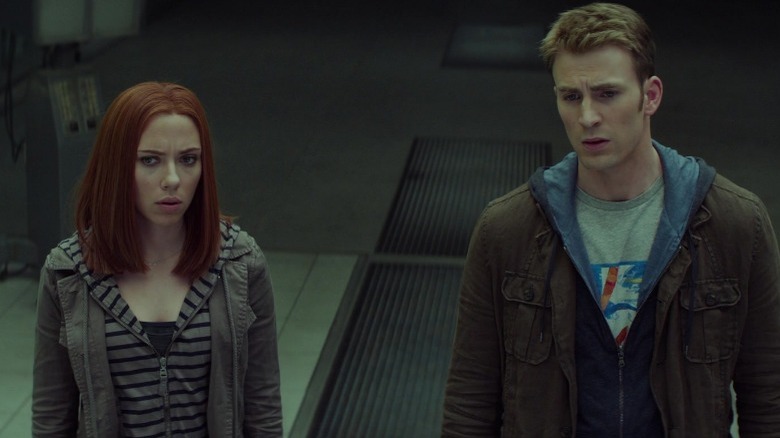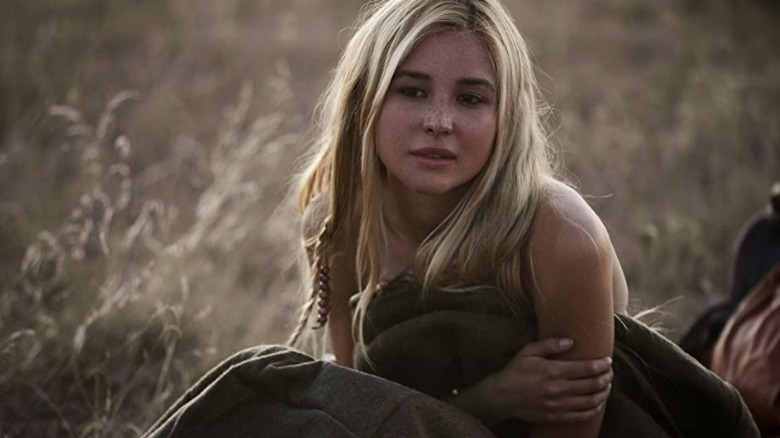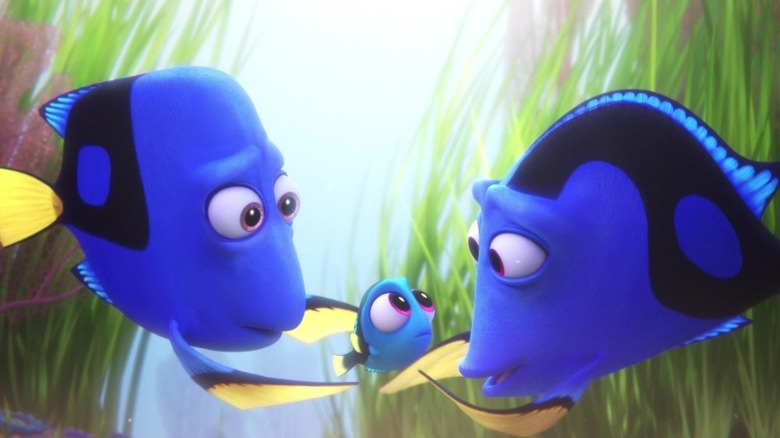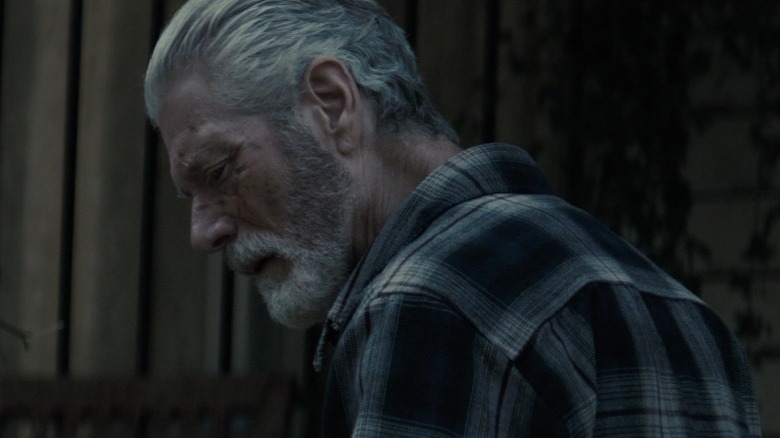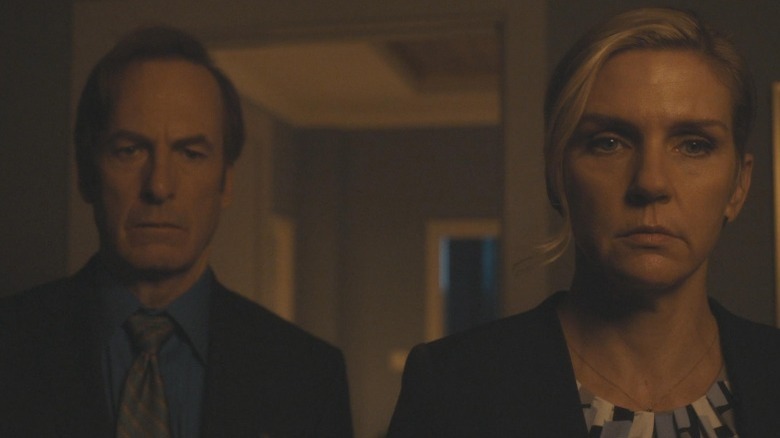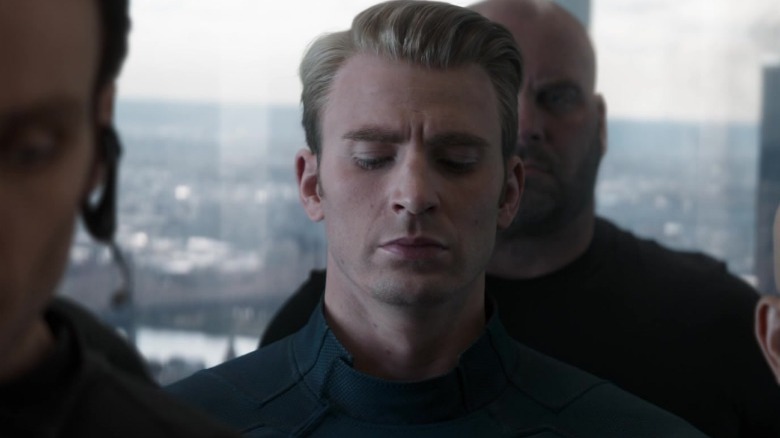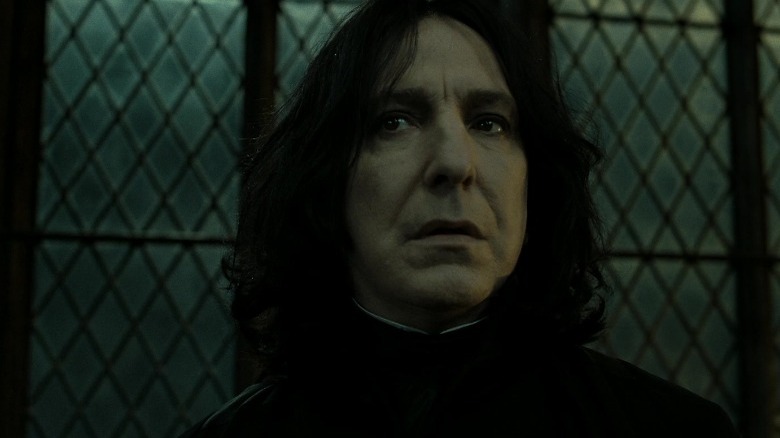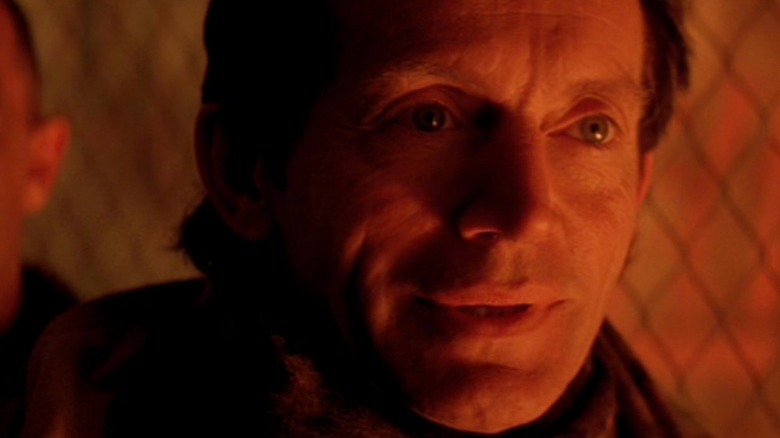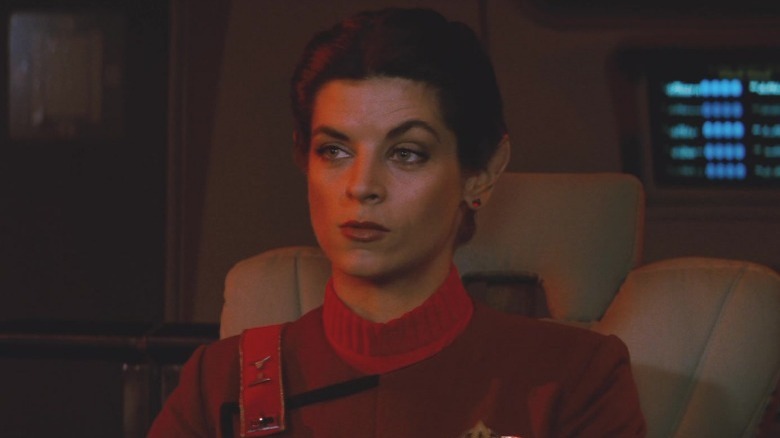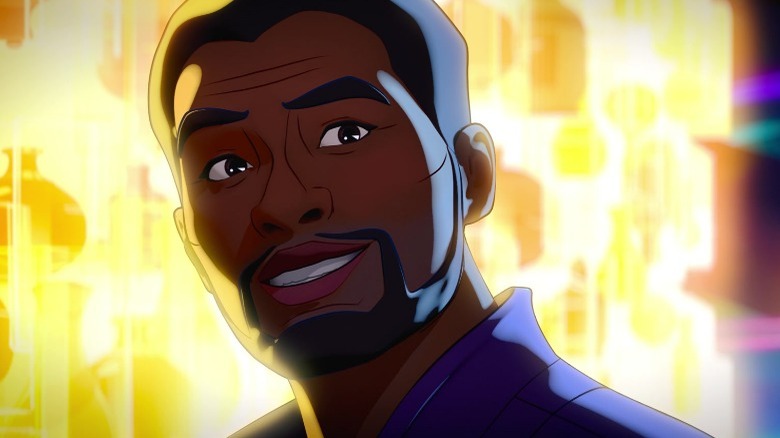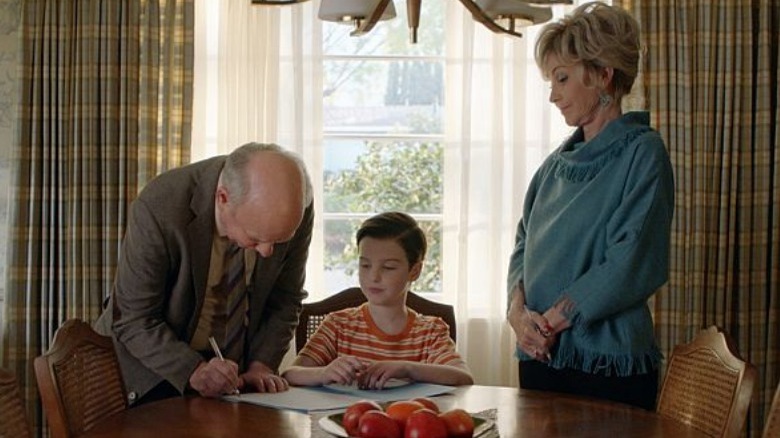Sequel Or Prequel Scenes That Change How We See The Original Show Or Movie
Just for a moment, imagine what "Star Wars" might have looked like without the plot twist about Darth Vader being Luke Skywalker's (Mark Hamill) father. Imagine if Darth Vader was just a random guy with no relation to Luke. Sure, the "Star Wars" movies would still be good fun, but they probably wouldn't have quite the same staying power (nor quite as many memes). By making a daring change in his original plans for the "Star Wars" trilogy, George Lucas created one of the greatest movie plot twists of all time.
A good sequel (or prequel) will not just send the characters in new and interesting directions but also enrich the movie or show that came before it. Even better is when a sequel is so revelatory that it makes you want to watch the original again, just to process everything you've learned. For instance, seeing the backstory of Dory (Ellen DeGeneres) in "Finding Dory" will change how you watch "Finding Nemo." And once the true allegiance of Snape (Alan Rickman) is finally revealed in the last "Harry Potter" movie, you can't help but rewatch all the previous films, hunting for the trail of breadcrumbs leading up to Snape's death. Here's a compilation of the best of these types of scenes — ones that changed the original story forever.
Darth Vader's identity revealed in The Empire Strikes Back
It's safe to say that the truth about Darth Vader (aka Anakin Skywalker) is no longer a spoiler. The twist is especially remarkable because it wasn't even in the filmmakers' original plans. Judging by earlier versions of the script, George Lucas had initially intended Darth Vader and Anakin to be two separate characters. The idea didn't even occur to him until he was working on "The Empire Strikes Back," and the twist was originally proposed as a joke, according to Marcia Lucas.
Yet amazingly, so many things from the original movie make sense in retrospect. In fact, fans can rewatch the scene from "A New Hope" where Obi-Wan (Alec Guinness) tells Luke about Anakin and find several subtle clues that suggest Obi-Wan wasn't telling the whole truth — no matter that these "clues" are purely coincidental.
Obi-Wan explains that Luke's uncle Owen (Phil Brown) disapproved when Anakin enlisted in the Clone Wars. "[Your uncle] thought he should have stayed here and not gotten involved," says Obi-Wan, and the way he glances off to the side suggests that he thinks Owen had a point. After all, if Anakin hadn't gotten involved, he might have never become Vader. Likewise, when Luke asks how his father died, Obi-Wan pauses noticeably before answering. He is technically lying when he tells Luke, "He betrayed and murdered your father," but if you want to be more generous, you could say that Obi-Wan is simply being figurative.
The Hydra plot twist in Captain America: The Winter Soldier
Since the beginning of the MCU, one thing seemed certain: SHIELD was the good guys. After all, it was the organization that had assembled the Avengers, and anybody who does that gets an automatic bonus in the eyes of Marvel fans. It certainly didn't hurt that SHIELD's nemesis was very obviously evil.
However, "Captain America: The Winter Soldier" changed all that. In this film, Captain America (Chris Evans) discovers that SHIELD and Hydra have become one and the same. Since the events of the first "Captain America" movie, Hydra has slowly infiltrated the ranks of SHIELD, and is hijacking SHIELD's weapons and resources to carry out its agenda. The sequel forces Captain America to begin questioning authority and reexamine his assumptions about right and wrong. Likewise, it makes audience members feel a little guilty for cheering at SHIELD's previous victories. Fans will realize with horror that Hydra must have been working behind the scenes the whole time, even during the Battle of New York in "The Avengers."
It's also worth noting that "Captain America: The Winter Soldier" set an entirely new precedent for the MCU. Fans no longer had to wait for the next Avengers movie to see plot points that would have a major impact on other Marvel films. This sequel proved that the events of one solo movie could ripple outward to affect the entire MCU.
Elsa's voice-over in the beginning of 1923
The harrowing ending of "Yellowstone" prequel series "1883" is not for the faint of heart. Elsa Dutton (Isabel May) dies a slow and painful death, even as her mother Margaret (Faith Hill) tearfully assures her she's going to make it. Meanwhile, Shea (Sam Elliot) commits suicide in hopes of joining his late wife. With so much death, you would think that at least Elsa's parents deserve a happy ending. Margaret and her husband James (Tim McGraw) vow to build a ranch in the spot where their daughter died, so the ending of the series suggests they will pick themselves up from this tragedy and carry on. Alas, it's not meant to be.
As if the ending of "1883" wasn't enough of a downer already, the companion series "1923" begins on an equally depressing note. Viewers may be surprised to hear a voice-over from Elsa, though the series soon reveals that audiences are hearing her spirit, who is watching over her family's land after her death. Elsa mentions that her father was shot and her mother froze to death, adding that only her two younger brothers and her uncle survived. So much for the hope that James and Margaret had finally found peace. It's upsetting to think that James and Margaret never got the chance to grow old under the tree where their daughter died. With this sobering knowledge, "Yellowstone" fans may find it even harder to watch the ending of "1883."
If you or anyone you know is having suicidal thoughts, please call the National Suicide Prevention Lifeline by dialing 988 or by calling 1-800-273-TALK (8255).
The glimpses of Dory's childhood in Finding Dory
In "Finding Nemo," Dory's short-term memory loss is a running gag. Sure, it moves the plot forward and helps Marlin (Albert Brooks) become a better parent, but it's still mostly played for laughs. However, watching "Finding Dory," fans will discover that Dory has her own tragic backstory to tell.
"Finding Dory" shows that it can be a nightmare to live in constant fear that you'll forget about the people you love. Viewers can feel the pain of Dory's parents as they worry about how their daughter will be able to take care of herself, and for the first time audiences know what it's like to see the world through Dory's eyes. In particular, the montage at the beginning of the movie, which shows young Dory growing up alone, reminds viewers how little they understood Dory in the first movie.
These moments from "Finding Dory" add a whole new layer to "Finding Nemo" if you watch it again. After watching the sequel, audiences will finally know the origins of Dory's "Just Keep Swimming" song. Also, Dory's monologue where she begs Marlin not to leave her becomes even more poignant after viewers realize how many people have left Dory before. Likewise, some of the jokes from the prequel will take on a much darker undertone. For instance, viewers will probably feel a pang of sadness whenever Dory says, "It runs in my family," before murmuring, "Where are they?"
Introducing Norman's daughter in Don't Breathe 2
Norman (Stephen Lang) from "Don't Breathe" certainly seems like a victim at first glance. After all, this blind man seems defenseless after three teenagers break into his home. Yet, as the movie unfolds, it becomes increasingly clear that Norman is the villain.
The sequel, "Don't Breathe 2," subverts our expectations once again. Early in the movie, viewers see the young girl Phoenix (Madelyn Grace) running from Norman's dog. It seems like Phoenix will be Norman's next victim, until the movie reveals that Phoenix is actually Norman's adoptive daughter and he is simply training her how to survive. Fans may be surprised to discover that Norman is actually a protective (albeit icy) father. It's especially shocking to see Phoenix be friendly to the dog that was so terrifying in the original film.
Now Norman is less a villain than an antihero. It seems he has moved away from kidnapping and rape, and has found a more tasteful way of having a child of his own: he rescued Phoenix from a fire and raised her as his own. Don't get us wrong, Norman is still quite ruthless and terrifying, but he's not quite the monster he was in the prequel. It may be difficult for viewers to reconcile these two sides of Norman. Whether you feel that "Don't Breathe 2" is humanizing a three-dimensional character or trying to excuse the actions of a despicable one, one thing's for sure — it will completely change how you watch the first movie.
Kim leaving Jimmy in Better Call Saul
Jimmy McGill (Bob Odenkirk), aka Saul Goodman, may just seem like a crooked lawyer in "Breaking Bad," but the prequel series "Better Call Saul" adds a whole new layer to his character. Viewers learn that Jimmy is deeply insecure and craves approval from his brother Chuck (Michael McKean), a once-great lawyer who never leaves the house anymore due to his "allergy to electricity." The worst part is that, even at his lowest, Chuck is still more respected than Jimmy.
But the scene from "Better Call Saul" that reveals the most about Jimmy is the moment from Season 6 when Kim (Rhea Seehorn) breaks up with him. It's especially heartbreaking because she admits that she does still love him. Yet Kim insists, "We're bad for each other," and that's why their relationship can never work. This is the final straw that completes Jimmy's transformation into Saul.
Knowing this about Saul, his callous behavior in "Breaking Bad" is a bit more understandable. With such a tragic backstory, it's easy to see why he's willing to sell out his own clients, urging Walter (Bryan Cranston) to kill Badger Mayhew (Matt Jones) in order to save his own skin. This may also explain why Saul is flirting with Skylar (Anna Gunn) one minute, and then telling her he can't imagine how she and Walter are still married the next. Perhaps Saul is a bit jealous that Walter managed to maintain his marriage for as long as he did.
The time travel scenes in Avengers: Endgame
Aside from being a mighty satisfying payoff for Marvel's Infinity Saga, "Avengers: Endgame" also enriches the previous films in the MCU by changing how we view moments from other movies. The time heist allows fans to revisit several iconic MCU scenes, but this time seeing them from a different angle.
For example, the introduction of Peter Quill (Chris Pratt) from "Guardians of the Galaxy" is hilariously put in perspective when we see it through the eyes of Nebula (Karen Gillan) and Rhodey (Don Cheadle). Rhodey sums it up perfectly when he says, "So he's an idiot?" Meanwhile, the trip to 2012 New York has some more surprises in store. Who would have guessed there would be an epic Captain America vs. Captain America battle in the Avengers Tower that was conveniently omitted from "The Avengers"? Plus the movie reminds us that the Hydra-controlled SHIELD had always been lurking in the background of the MCU.
Perhaps the most head-spinning reveal is that, after the events of "Endgame," Steve Rogers (Chris Evans) goes back in time so he can be reunited with Peggy (Hayley Atwell) and they can grow old together. This means, of course, that Peggy Carter's husband, mentioned in "The Winter Soldier," is none other than Cap. Peggy must have known the whole time. The screenwriters of "Avengers: Endgame" have confirmed that Rogers was indeed the father of Peggy's kids.
Snape's death in Harry Potter and the Deathly Hallows -- Part 2
Let's be honest: Harry Potter (Daniel Radcliffe) isn't exactly the best judge of character. He completely misjudges Sirius Black (Gary Oldman) and assumes at first that Tom Riddle (Christian Peter Coulson) must be a great guy. However, Harry's biggest mistake is believing that Severus Snape is evil. "Harry Potter and the Deathly Hallows — Part 2" reveals that Snape was a good guy all along; he was simply a double agent pretending to work with Voldemort. Unfortunately, Harry only realizes this as Snape lies dying.
Suddenly, everything Snape does throughout the series makes sense. Fans will know why Snape sneaks around during the troll attack — because he's investigating Quirrell (Ian Hart) — and why he kills Dumbledore (Michael Gambon) — because Dumbledore asked him to. If fans rewatch the werewolf attack from "Harry Potter and the Prisoner of Azkaban," they will notice Snape shielding the kids with his body. And of course, whenever Dolores Umbridge (Imelda Staunton) is interrogating Harry in "Harry Potter and the Order of the Phoenix," Snape actually does Harry a favor, telling Umbridge that he is out of Veritaserum (probably a lie). After Harry warns Snape that Sirius is in danger, Snape pretends not to know what he's talking about. Obviously Snape knows who "Padfoot" is; he just denies it to preserve his cover. In hindsight, viewers will know that Snape must have warned Dumbledore right away. Of course, that doesn't necessarily mean he didn't enjoy seeing the look on Harry's face.
The reveal of Bishop II in Alien 3
Fans who loved the faithful android named Bishop (Lance Henriksen) from "Aliens" will probably be devastated when the character dies in "Alien 3." However, in the climax of the movie, viewers will be unsettled to discover that Bishop appears to be back from the dead. It turns out that this isn't Bishop, but the man who built him. Known only as "Bishop II," this man from the Weyland-Yutani Corporation designed Bishop to look exactly like him.
While the two characters share the same face, they couldn't be more different. Bishop is willing to sacrifice himself to save Ripley (Sigourney Weaver), while Bishop II cares only about harvesting the xenomorph inside her. Bishop II isn't an android programmed to carry out the bidding of the Weyland-Yutani Corporation; he's an actual human being who sees the xenomorph as a "magnificent specimen," which is infinitely creepier.
His appearance is jarring because fans need to reconcile these two characters who look exactly alike. Bishop II is just as cunning and callous as Ash (Ian Holm) from the first movie, but what makes this man somehow worse is that you almost want to believe him. How can you not, when he has Bishop's face? If fans rewatch "Aliens" after seeing this moment from "Alien 3," they will never be able to look at Bishop the same again.
The simulator test in Star Trek II: The Wrath of Khan
When choosing a villain for the movie "Star Trek II: The Wrath of Khan," the filmmakers turned to the original TV series. After defeating the genetic superman Khan (Ricardo Montalban) in the TV series episode "Space Seed," Captain Kirk (William Shatner) exiles Khan and his people to the uninhabited planet Ceti Alpha V. However, Kirk never bothers to check on them, so he doesn't realize that Khan spends 15 years in an uninhabitable wasteland. The sequel demonstrates that Kirk's well-meaning actions can have far-reaching consequences.
The sequel sets a totally different tone from the original series, right from the opening scene, in which Lieutenant Saavik (Kirstie Alley) makes a decision that endangers the entire Enterprise. For a moment, it seems like the Klingons kill everybody, including Spock (Leonard Nimoy). Although viewers are relieved to learn it's just a simulation, the opening sequence shows fans a darker and more mature version of the "Star Trek" universe. It's a painful reminder that the crew of the Enterprise might need to face a "no-win scenario" like the one shown in the simulation, and that it's possible for more than just redshirts to die. In fact, Spock actually dies for real later in the movie. Even though Spock is resurrected in the sequels, this scene still has a lasting impact on the "Star Trek" universe.
T'Challa and Thanos teaming up in Marvel's What If ...?
One could argue that every single episode of "What If ...?" completely transforms how fans view the rest of the MCU. However, there's one episode from Season 1 that is particularly eye-opening: "What If ... T'Challa Became a Star-Lord?" The episode shows us one of the most unlikely team-ups in the entire multiverse: T'Challa (Chadwick Boseman) and Thanos (Josh Brolin).
Not only does T'Challa thwart Thanos' plan to decimate the universe, but he sways Thanos to join the good guys as the two become best buddies. Along the way, T'Challa prevents Ronan (Lee Pace) from killing Drax's (Dave Bautista) family and brings out the more nurturing side of Yondu (Michael Rooker). T'Challa seems to do all these things effortlessly, suggesting that the universe would be a much better place with T'Challa as Star-Lord instead of Peter Quill. Since this episode was released after the death of Chadwick Boseman, it only strengthened fans' appreciation for the late "Black Panther" star's deeply humane portrayal.
Fans will also notice that this episode technically disproves the prediction Dr. Strange (Benedict Cumberbatch) made in "Infinity War" about how there would be only one possible outcome in which the Avengers would beat Thanos. Obviously, this was before the multiverse even existed, so at the time there was technically no alternate universe where T'Challa had befriended Thanos. Still, Dr. Strange seriously underestimated the power of T'Challa.
Sheldon writing his first contract in Young Sheldon
A running gag in "The Big Bang Theory" is the "Roommate Agreement" between Sheldon (Jim Parsons) and Leonard (Johnny Galecki). This is a contract that the two roommates sign to spell out what they can and cannot do while living together — and Sheldon doesn't hesitate to cite the exact clauses that he feels Leonard is violating. A scene from "Young Sheldon" explains where Sheldon (Iain Armitage) first got this idea as a kid. What's more, it allows fans to understand why Sheldon cares so much about contracts, so perhaps they will view these scenes from the original show differently.
According to the episode "Vanilla Ice Cream, Gentleman Callers, and a Dinette Set," Sheldon's first contract is created to help his Meemaw (Annie Potts) while she's dating Dr. Sturgis (Wallace Shawn). Sheldon can't help but overhear Meemaw arguing with Sturgis (and also can't help spying on them with binoculars). He wants things to work out between Meemaw and her new boyfriend, so he offers to draft a relationship contract so the couple can establish boundaries. It's a sweet gesture from Sheldon that shows how much he loves his Meemaw.
Of course, this sentimental moment doesn't hold a candle to another scene from "The Big Bang Theory" involving Sheldon and his Meemaw. Fans are sure to find that scene extra sad after watching "Young Sheldon," which shows just how much the prequel series elevates the experience of watching the original series.
